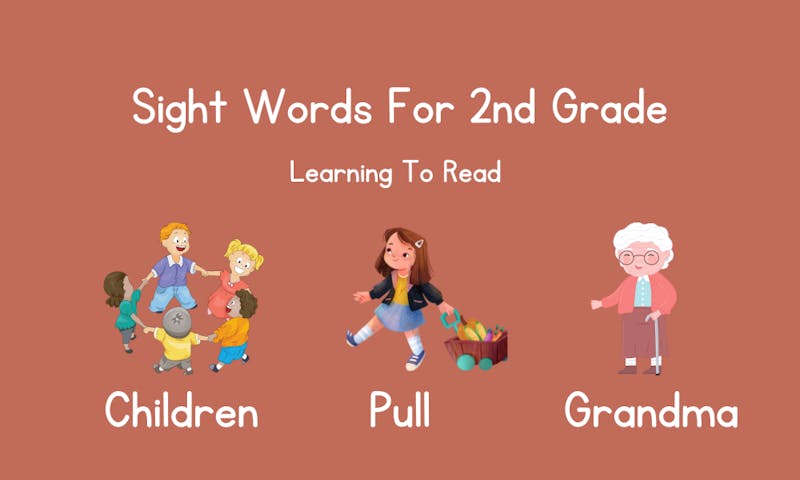Sight words for 2nd grade are high-frequency words like are, easy, second, make, and about. Little children start learning sight words as soon as they start school, and these are words they will hear and encounter in books, conversations, and texts from a young age. Sight words at the 2nd-grade level get a little more complex for engaged students as they improve their comprehension and communication skills when speaking, reading, writing more meaningful sentences, and working on sentence formation. Sight words in the 2nd grade are:
- A step towards identifying high-frequency words.
- To help students decode other words.
- Often called wall words in the 2nd grade. They are highly visible words designed to be an interactive resource for children to refer back to. They are typically alphabetized and placed on the wall or whiteboard.
- Sight words are memorized as whole words because they don’t always follow simple decoding patterns.
Why Do We Teach Sight Words?
Teaching high-frequency words can create proficient and fluent children who don't need to decode every letter sound when they read, thus helping them to understand and read sentence structures. But how do we help our children or students learn sight words in the 2nd grade? Carry on reading, and we'll give you some second-grade Dolch sight words, a high-frequency word patterns list, and some tips and tricks to engage and support your readers on their emerging reader journeys.
2nd Grade Dolch Sight Words
Here are some grade-level appropriate Dolch sight words for 2nd graders to familiarize themselves.You can use this high-frequency list to inspire your classroom word wall or to refer to when you need a sight word for the week.
| always | or | around |
| pull | because | been |
| read | right | second |
| make | usually | another |
| first | won | thank |
| into | really | found |
| which | why | these |
| since | sometimes | piece |
| sister | eating | favorite |
| small | question | jump |
| city | young | don't |
| kicked | goes | line |
| too | joke | won't |
| Mr. | Mrs. | often |
| would | very | wish |
| father | mother | brother |
| grandma | grandad | old |
Dolch Sight Word Example Sentences
If you're struggling to expose your 2nd-grade students to high-frequency words, check out our simple example sentences using Dolch sight words. They are suitable for 2nd-grade learners. Use them to refer back to the familiar words in small reading groups or as an engaging resource at home to increase your children's sight word fluency and familiarity.
- Mr. Thompson is my teacher. He tells lots of jokes.
- My father is tall.
- Read and answer the question.
- He kicked the ball.
- My sister won the game because she is young.
- I live with my mother, brother, and sister.
- Her favorite food is apples.
- What is the question?
- I wish I had a cat.
- I always brush my teeth before bed.
High-Frequency Word Patterns For 2nd Graders
These high-frequency word lists show children how words are made from repeated suffixes and common phonetic patterns. They can help children decode words with common prefixes and suffixes, vowel blending, and spelling-sound correspondence as per the Common Core Standards for 2nd-grade reading foundational skills –CCSS.RF.2.3 and CCSS.RF.2.3C.
Long-Ol- Pattern
Here are some -oi- words.
| boil | point | coil |
| join | toil | void |
| loin | oil | coin |
Long-Ai- Pattern
Here are some -ai- words.
| sail | rain | chain |
| time | paint | brain |
| pain | stain | fail |
Long-Ight- Pattern
Here are some -Ight- words.
| night | light | bright |
| fright | tight | sight |
3 Sight Word Activity Tips To Engage Your 2nd Grader
Learning to read is a hugely important life skill. It's the first step to reading fluency and understanding and comprehending what we read. 2nd-grade sight word lists are a great easily-accessible educational resource to help bilingual children, struggling readers, and emerging readers. Sourcing and creating fun and interactive resources to help 2nd graders master 2nd-grade sight words can be difficult, especially if your student or child lacks confidence or if you have different levels of fluency in your classroom. Stuck for an idea for children? Here are a few tips and tricks.
- Place focus on a few sight words per week. This is hugely important, especially in engaging students. Choose around 3-5 2nd-grade sight words per week to put on a visual word wall. Once students have mastered these, you can swap them around. If your child struggles with sight words at home, focus on a few per week and have them easily accessible around the house, where they will see them daily.
- Use visual manipulatives like ABC charts and interactive sight-word charts where they build the word using small objects. You could even plan a sight word scavenger hunt where children have to find the sight words dotted around the room. Planning engaging sight word activities in the 2nd grade doesn't have to be boring!
- Grab a small whiteboard and play Pictionary using sight words for 2nd grade. For many kids, it's much easier to visualize a word when they have a picture to refer back to.
FAQs - Sight Words For Second Grade
Check out our frequently asked questions regarding sight words for 2nd graders.
What are sight words?
What are the top 10 sight words for 2nd grade?
How many sight words should a 7 year old child know?
How can sight words improve my child's reading skills?
How can sight words improve my child's spelling skills?
How do teachers use sight words in the classroom?
